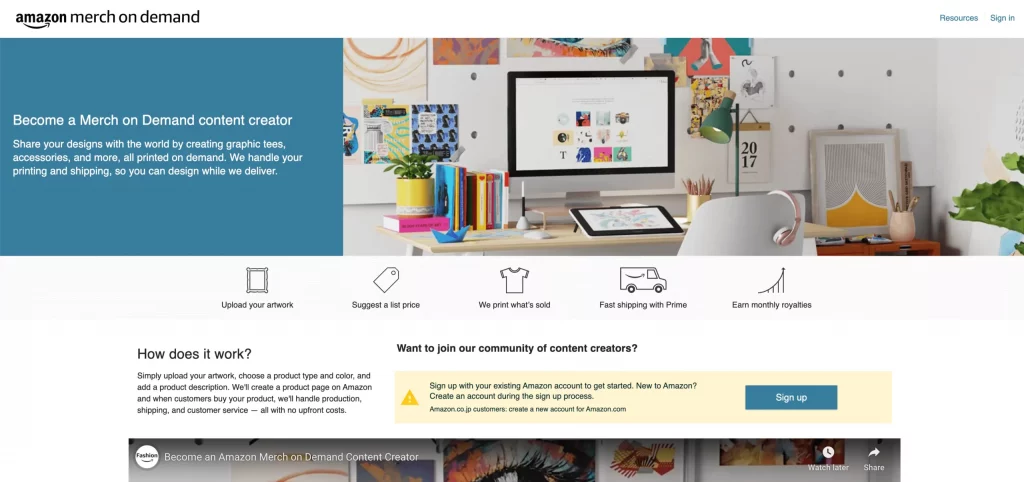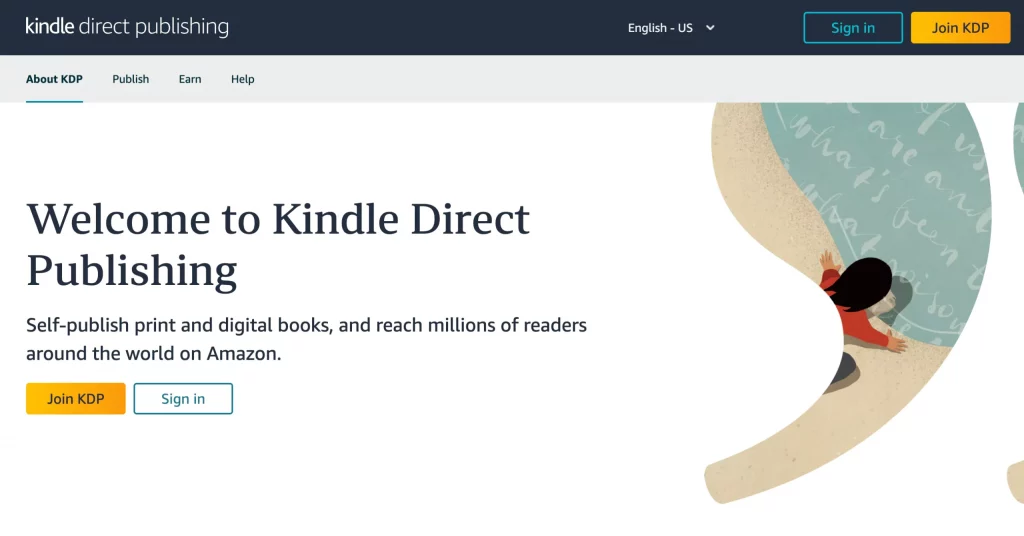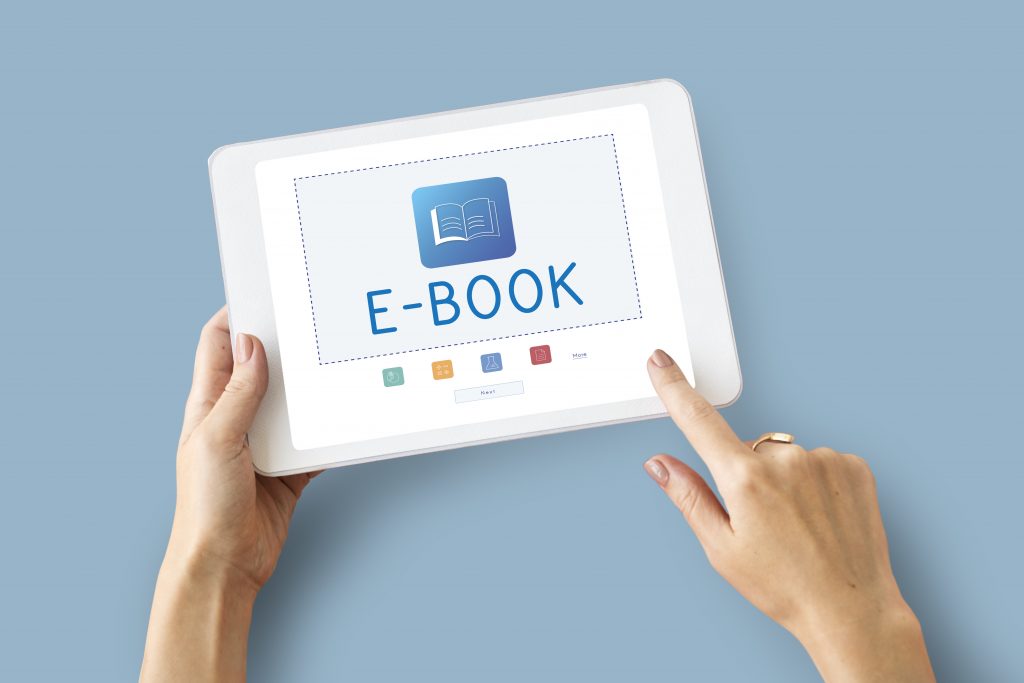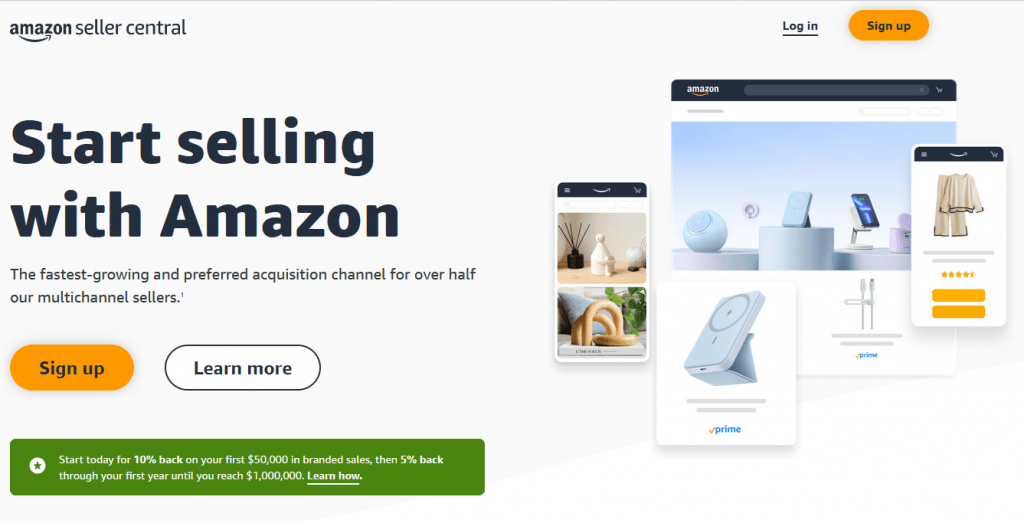There are four key strategies for how to sell on Amazon without inventory: dropshipping, utilizing Merch by Amazon for print-on-demand services, publishing with Kindle Digital Publishing (KDP), and offering digital products.
These methods are ideal for those eager to enter the Amazon marketplace without the hefty initial investment typically associated with stocking up on inventory, perfect for starting a private label venture.
In the following discussion, we’ll delve into each of these avenues, highlighting the distinct benefits and potential hurdles you might face with each approach.
Whether your interest lies in e-commerce, creating custom merchandise, venturing into self-publishing, embracing print-on-demand, or marketing digital products, we aim to equip you with the essential knowledge and tools to begin your Amazon selling adventure without the need for traditional inventory.

Table of Contents
ToggleTo Maintain Inventory or Not: The Crucial Decision
Embarking on a private label journey demands considerable dedication, not just in terms of effort but also financially.
Initiating a private label endeavor necessitates a substantial initial investment, often around $10,000, to secure your first batch of inventory.
This figure can vary based on your chosen niche and includes the cost of the entire shipment to ensure you don’t deplete your stock too quickly, the products are sold and shipped by Amazon instead.
It’s generally advised to maintain at least a 90-day stock. To calculate this, multiply your anticipated daily sales by 90. For instance, if you plan to sell 10 items daily, you’ll need 900 units to cover three months.
If each unit is priced at $10, your inventory expenditure would be around $9,000, excluding additional costs like shipping, taxes, and marketing.
Yet, it’s possible to commence with less. Take Bradley from SKAB, for example, who kickstarted with a mere $5,000 and expanded his venture significantly. Such instances show that with strategic financial planning, you can indeed start smaller.
For those with limited startup capital, exploring how to sell on Amazon without inventory presents an attractive avenue. This approach includes selling digital products on Amazon or venturing into the world of print-on-demand, like creating and selling eBooks or t-shirts.
This strategy not only mitigates the need for a hefty initial investment but also aligns perfectly with how to sell on amazon without inventory upfront, offering a viable pathway to gradually accumulate funds for a future private label venture.
Different Methods of None Inventory Selling
Let’s dive into the various strategies. Whether you’re aiming to establish a physical product line, launch digital goods, or explore service-based offerings, each method comes with its unique set of processes, benefits, and considerations.
1. Dropshipping
Dropshipping on Amazon is a process where the manufacturer creates and directly ships the product to the customer on behalf of the seller. This business model is widely embraced by countless sellers globally, offering a streamlined approach to e-commerce.
In this model, sellers identify potential products, which are sold and shipped by Amazon instead, to list on Amazon and partner with dependable suppliers for product provision. After listing the product on Amazon, when a sale is made, the seller then purchases the item from the supplier at a lower cost, capitalizing on the margin for profit.
The advantages of Amazon dropshipping are numerous, including the elimination of handling and storing inventory, the flexibility to market the product across various platforms, and the ability to reach international markets while concentrating on customer service. It’s an attractive model for those seeking to minimize upfront investment, potentially paving the way for passive income generation.
However, there are notable drawbacks, such as limited control over product quality and the supply chain, relatively thin profit margins, and heightened competition compared to selling unique private label products because the products are sold and shipped by Amazon. These challenges underscore the importance of effective customer service management in sustaining a successful dropshipping business on Amazon.
2. Merch by Amazon or Print on Demand

The second method to explore is Merch by Amazon or print-on-demand services.
Merch by Amazon, also recognized as Merch on Demand, is a platform that empowers graphic designers and digital artists to sell their unique designs without the need for upfront investment or inventory.
Once approved for the program, creators can feature their designs on assorted products selected from Amazon’s catalog, which are sold and shipped by Amazon.
When a customer makes a purchase, the creator earns royalties, essentially allowing them to sell on Amazon without holding any inventory or incurring upfront costs. Here’s a look at the advantages and disadvantages of using Merch by Amazon:
Pros of Merch by Amazon:
- Zero capital investment is required to start.
- Amazon provides a tool to create product mock-ups.
- Products are eligible for Amazon Prime, enhancing customer trust and reach.
- Direct exposure to Amazon’s extensive customer base.
- Potential to secure a significant share of sales revenue without dealing with fulfillment and storage costs.
Cons of Merch by Amazon:
- Access to the program is limited and requires an invitation from Amazon.
- The range of products you can design for is somewhat limited, which are sold and shipped by Amazon.
- There’s no capability to list these products on other platforms, restricting sales to Amazon only.
This method aligns with strategies like how to sell on Amazon without inventory, how to sell digital products on Amazon, and how to sell clothes on Amazon, providing a streamlined pathway to market without the traditional e-commerce barriers.
3. Kindle Digital Publishing (KDP)

Next up is Amazon KDP, short for Kindle Direct Publishing. This platform empowers authors and publishers to independently publish and distribute their books directly on Amazon.
With KDP, you have the option to release digital e-books compatible with Kindle devices or opt for physical print copies that echo traditional bookstore offerings.
KDP grants you the prestigious title of author, allowing you to swiftly upload your manuscript and cover art, set your pricing, and access Amazon’s extensive global audience through the Kindle Store.
The setup process is remarkably user-friendly; you can have your book live on the platform within just a few minutes after uploading.
Curious to learn more?
Tune into the latest episode of the Serious Seller’s Podcast, where I delve into how you can craft and publish your debut book in just 24-48 hours.
Alternatively, you can find more information on setting up your Kindle Direct Publishing account here.
Pros of Amazon KDP:
- Zero upfront costs
- Quick and straightforward setup
- Access to Amazon’s vast international customer base
- Enhanced control and adaptability with Kindle Direct Publishing
- Accessible key metrics and analytics to refine your publishing approach
Cons of Amazon KDP:
- Intense competition within the marketplace
This platform is a fantastic avenue for how to sell on Amazon without inventory, particularly focusing on how to sell digital products on Amazon, and also aligns with strategies for how to sell books or even how to sell clothes on Amazon when considering print-on-demand options, all without the necessity of buying products upfront.
4. Digital Products

Venturing into the realm of digital product sales on Amazon presents an attractive avenue for generating income without the necessity of maintaining physical stock.
Indeed, Kindle books are a prime example of digital offerings, but let’s broaden the horizon. Consider Amazon Music or the plethora of digital goods you can offer.
Much like dropshipping, selling digital products can pave the way for ‘passive income,’ often boasting higher profit margins due to lower overheads.
Examining the pros and cons: On the upside, digital products deliver instant gratification to consumers, sidestepping traditional shipping demands and slashing logistical costs. Their scalability is another bonus, allowing effortless duplication and distribution sans extra production costs, especially when leveraging Amazon’s vast customer reach.
For creative minds, venturing into digital art or audiobooks can cement control over your intellectual creations and usher in continuous earnings via licensing deals.
Conversely, the specter of digital piracy looms large, posing risks of unauthorized replication and distribution of your work. Thus, safeguarding your digital assets against piracy and competitive theft is paramount in this digital marketplace.
Key Factors in Mind While Selling Without Inventory
We are not highlighting challenges to discourage you, but rather to illustrate that each business model has its nuances to consider.
For an approach like dropshipping, clear communication is your lifeline to success. Being upfront about shipping durations, product statuses, and possible delays is vital in building trust.
Transparency allows you to set realistic expectations for your customers regarding shipping fees and timelines, which are crucial for enhancing customer satisfaction when you’re not managing inventory first-hand.
- Dropshipping adds a layer of complexity, particularly in upholding product quality without direct inventory oversight. This necessitates a strong partnership with your suppliers, enforcing strict quality checks, heeding customer feedback, and promptly addressing any issues that arise.
- Moreover, getting acquainted with regulations concerning product safety, labeling, and consumer rights ensures your business adheres to legal standards, avoiding unnecessary fines. Steering clear of prohibited items also facilitates a smoother selling journey.
Here’s your resource for Amazon’s restricted categories and brands.
- Additional key points include choosing a dependable payment processor, employing tech solutions to optimize operations, and favoring products that are compact and lightweight to reduce storage expenses. Adopting a pricing model that marries competitive pricing with a marginally higher rate can help sustain profits and fund future business growth.
- Tools are invaluable for pinpointing in-demand products, while others can aid in understanding market trends. Selecting items that resonate not just on Amazon but across platforms like Instagram and TikTok can broaden your revenue sources.
- Regardless of the business model, thorough product research is imperative, akin to what you’d undertake for private labeling. Identifying items with robust demand ensures your investment in time, money, and effort is justified.
- Furthermore, tailor your market research to your specific product category. For instance, if you’re venturing into t-shirts, leverage tools for insights on profitable opportunities. Similarly, if you’re focusing on Kindle books, utilize relevant tools to gauge the market directly within the Kindle Store. This detailed research approach is pivotal for any item you plan to sell, ensuring its market viability and profit potential.
How To Sell On Amazon Without Inventory
We’ve explored various methods, each with its unique process. For example, Kindle Direct Publishing (KDP) operates distinctly from Seller Central, catering specifically to those looking to publish digital or print books.
To dive deeper and initiate your journey, I recommend exploring the articles I’ve linked to gather more comprehensive insights on your chosen path.
For those inclined towards dropshipping, retail arbitrage, or starting a private label with inventory, the next step is setting up a Seller Central account on Amazon.
Below are the actionable steps to kickstart the process of listing your own product:
1. Set Up Your Amazon Account

Amazon Seller Central serves as the hub for sellers aiming to oversee their physical goods business on Amazon. It offers an intuitive dashboard that facilitates easy monitoring of product listings, inventory management, order processing, and customer service enhancement.
To initiate your journey as an Amazon seller, you should navigate to https://sell.amazon.com and select the ‘Sign Up’ option. The registration process is straightforward, enabling you to manage your product listings, inventory, and orders efficiently once you have your account set up.
For those embarking on their Amazon selling venture, deciding between an Individual or a Professional plan is crucial. Opting for the Professional plan is generally advised for those aspiring to expand their business, given its access to more sophisticated features.
2. Discover a High-Profitable Product
Amazon product research is a critical process that involves a thorough examination of Amazon’s vast marketplace to pinpoint potential best-selling products, which are sold and shipped by Amazon. With countless items listed, identifying the right ones can significantly elevate a small Amazon business to notable success, but this requires diligent research.
Tools offer a streamlined way for sellers to uncover promising products by setting specific search parameters such as projected sales revenue, level of competition, and other key factors. These tools are not just limited to finding opportunities for arbitrage or private labeling but encompass a broader spectrum of potential product niches.
While finding one successful product is a great start, achieving ambitious business goals usually necessitates identifying a series of profitable items. SKAB, offering a Chrome Extension for Amazon sellers that provides instant access to in-depth product insights, reviews, and sales projections.
After pinpointing potential hits, further validation is essential. Tools like Xray within the suite allow for a deep dive into product viability, comparing sourcing costs from platforms like AliExpress and Alibaba, and estimating overall profitability.
For a comprehensive financial analysis, FBA calculator enables sellers to factor in up to 20 different cost variables, ensuring a well-informed decision-making process. This level of detailed analysis helps alleviate stress and boosts confidence as sellers make crucial business moves.
To expand your knowledge and discover multifaceted strategies for Amazon product research, engaging with educational resources like Bradley’s masterclass can offer new perspectives. By grasping fundamental research concepts, you can learn to interpret data effectively and uncover a variety of profitable Amazon products, enhancing your selling strategy.
3. Create Your Product

To launch a product on Amazon effectively, adhering to Amazon listing optimization protocols is essential. Key elements to refine include your product title, bullet points, description, image selection, and keyword strategy. Note that this approach may differ if you’re engaged in retail arbitrage.
Identifying the optimal keywords is a pivotal step in crafting your product listing. With a tool like Magnet, you can unearth pertinent keywords that bolster your product’s visibility and competitiveness within your market segment.
After pinpointing the right keywords, it’s time to craft your product title, develop five compelling bullet points, and articulate a coherent product description. It’s vital to integrate keywords smoothly and contextually within your content rather than forcibly stuffing them.
The imagery selection is your next critical move, adhering to Amazon’s image criteria to enhance your listing’s appeal. Utilizing the Chrome Extension allows you to assess the Listing Health Score of competing Amazon listings, providing insights into image best practices. Ideally, your listing should showcase 7 or more images, including a primary image set against a white backdrop, with each picture maintaining a minimum short side dimension of 1,000 pixels.
By following these guidelines, you’re well-equipped to position your product effectively on Amazon, whether you’re exploring how to sell on Amazon without inventory, leveraging ‘sold and shipped by Amazon’ services, venturing into digital products, learning how to sell clothes on Amazon, or understanding how to sell on Amazon without buying product directly.
4. Utilize Our Product Launch Techniques
Diving into Amazon product launch strategies is an essential move for any seller aiming for a triumphant introduction of their product.
Sure, I could list numerous strategies here, but let’s keep it simple. Just hit the link provided above to delve deep into the wealth of information!
Believe me, pinpointing the perfect launch tactic can significantly elevate your product’s profile, ramp up your sales, and position your offering as a top contender on Amazon.
To give you a quick overview, these Amazon launch strategies are essentially well-crafted plans for debuting new (or existing) products, which are sold and shipped by Amazon. on the marketplace. By deploying a carefully orchestrated launch, you enhance your product’s exposure and attract a broader audience right off the bat.
Launching a product on Amazon might seem daunting, but with adequate financial backing, a standout product, and a strategic approach informed by SKAB insights, you can navigate this process with greater ease and confidence. Whether you’re looking into how to sell on Amazon without inventory, aiming to have your products sold and shipped by Amazon, exploring how to sell digital products or clothes, or figuring out how to sell on Amazon without purchasing inventory firsthand, these strategies are invaluable.
5. Learn From the Best
And if you’re anything like me, well, perhaps you prefer a more human touch.
You should know SKAB offers a real and viable path to achieving success on Amazon and other e-commerce platforms with Freedom Ticket, our course is typically included in our tiered plans and covers a host of topics from choosing a product to sell on Amazon to effectively utilizing Amazon advertising to increase your product’s visibility.
6. Use Tools to Manage Your Business
After you’ve acquired the essential skills to excel on Amazon and outperform your competitors, it’s time to put that knowledge into action by leveraging our comprehensive Amazon software consultation. With these tools at your disposal, you’ll approach product research, sourcing, and selling with the expertise of a seasoned e-commerce pro.
Utilize features like Follow Up to prompt customer feedback and reviews, enhancing your product’s credibility and visibility. Employ Keyword Tracker to monitor your product rankings, ensuring you stay ahead in search results. And don’t forget to use the Insights Dashboard, a powerful tool that helps you refine your operations, analyze your product’s performance, and boost your e-commerce sales effectively.
These tools are designed to provide you with a competitive edge, whether you’re exploring how to sell on Amazon without inventory, looking into options for having your products sold and shipped by Amazon, discovering how to sell digital products or apparel on the platform, or mastering how to sell on Amazon without initially purchasing products.
Conclusion
Indeed, there are numerous pathways to embark on Amazon selling without maintaining an inventory, each presenting its unique set of pros and cons. By dedicating time to research and understand the selling strategies that resonate with you, you’re setting a strong foundation for a successful venture on Amazon.
For those new to Amazon and equipped with substantial starting capital, venturing into private label selling can be highly rewarding. Conversely, newcomers with limited funds might find success with other strategies that don’t require significant upfront investment yet are equally potent in generating sales.
When you’re poised to delve deep into Amazon selling, consider exploring our comprehensive array of Amazon tools designed to assist you in discovering promising products, sourcing them efficiently, launching them on the platform, and promoting them effectively. Here’s to your exciting journey and future achievements as an Amazon seller!
